Yesterday I had the pleasure of visiting Macari Vineyards, a beautiful winery located in Mattituck (North Fork of Long Island). I visited Macari a few years back and enjoyed my time there, and this visit was also a wonderful experience. The vineyard and tasting room are lovely and the wines are excellent quality, and the winery prides itself also on its knowledgeable and friendly staff.

Gibson began the tasting with the 2010 Sauvignon Blanc, a new release from what appears to be an extraordinary year for Long Island wines, due to weather conditions during the ripening season. The wine is a very pale straw color with hardly any water rim, indicating its youth. The aromas are very indicative of the varietal, with lively citrus, green apple, peach, white flowers, and grassy notes. The flavors were a bit more tart than the aromas would indicate, including grapefruit, and hints of peach, herb, and good minerality. The wine shows bright acidity and excellent balance, a crisp clean texture, and a long finish.

Next was the Collina 48 Chardonnay, a nonvintage blend of 2008 and 2009. This is a very pale Chardonnay with a bit of Sauvignon Blanc in the blend, with a faint water rim and modest alcohol. The aromas are indicative of Chardonnay, including lemon zest, red apple, pear, and stony soil. The flavors are more crisp, including bright citrus and green apple. The wine is smooth and very enjoyable and very reasonably priced as well.
 |
| 2010 Sauvignon Blanc and Collina 48 Chardonnay |
We then moved on to the 2007 Estate Chardonnay. The wine is straw colored but not quite so pale as the first Chardonnay. The characteristics included tangerine and a hint of lemon and white fruit, and interestingly, a bit of fig. The flavors confirmed the aromas, but also showed tropical fruit, with lots of bright acidity and a long, clean finish.
 |
| 2007 Estate Chardonnay and 2007 Reserve Chardonnay |
Next was the 2007 Reserve Chardonnay, which spent time in contact with French oak and it was evident as soon as I observed the wine in the glass - it is a yellowish color with a clear rim, and the aromas include white citrus, baked apple and pear, ginger, baking spice, and a hint of bacon fat. The flavors confirmed the aromas and added a bit of earthiness, as well as tropical fruit and pineapple, and yeasty bread flavors, yet the wine is so clean and crisp, particularly on the finish - the palate feels so clean. This wine seems as though it would be especially nice to pair with local seafood.
I then tasted the 2010 Riesling. The grapes are not from Long Island - rather, they are from the Finger Lakes region, but the wine is produced by Macari. Regarding appearance, the wine is a light straw color, and after swirling and noting the viscosity of the wine, it was clear that this Riesling has a higher alcohol content than a typical German Riesling. The aromas include apricot, peach, white blossom, and underlying lime and pink grapefruit, and the flavors confirmed the aromas, with a balance of sweeter fruit flavors and racy acidity. The wine is so easy on the palate and has a soft and lovely finish, and I really enjoyed this wine.
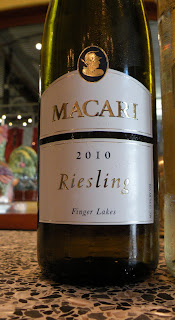 |
| 2010 Riesling |
We then went back for one more Chardonnay, the 2010 “Early Wine,” which is a wine made of Chardonnay grapes picked early and sent through production to bottling very quickly. The color is extremely pale, with characteristics of youthfulness, light citrus, melon, green apple, and white flowers, with a bit of tropical fruit on the palate, but overall the wine has very green and bright characteristics. I liked the refreshing uniqueness coupled with the nice balance and acidity, and the very long finish.
 |
| 2010 Early Wine Chardonnay |
Rose is so popular this year and Macari’s 2010 Rose certainly didn’t disappoint. It is a blend of mostly Merlot and other Bordeaux varietals, and has a beautiful salmon pink color. The aromas include cherry (but not sour), strawberry, a hint of watermelon, and a bit of herb and stony soil. The flavors were reminiscent of tart cherry, strawberry, and fresh watermelon, and the wine shows bright acidity and a happy sort of personality with a long finish and lovely balance. I really enjoyed this wine very much, I believe it is quite food friendly and I look forward to its release so I can enjoy it again.
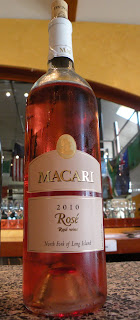 |
| 2010 Rose |
And then it was time to move on to the reds. First was the 2008 Cabernet Franc, a ruby colored wine that showed notes of berry and plum laced with smoke, spice, earth, and just a touch of oak. Cabernet Franc is a very successfully grown grape on Long Island, and Macari’s Cabernet Franc is an excellent representation of the varietal, with its excellent balance of acidity and tannin, followed by its long finish - I loved the structure and texture of this wine.
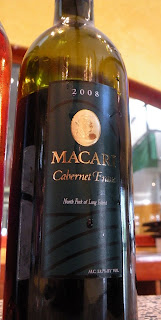 |
| 2008 Cabernet Franc |
The next red was the Sette, a nonvintage wine of about half Merlot and half Cabernet Franc, probably the two most important red grapes on Long Island. The wine shows an Italian influence, as intended by Macari, and while I observed the ruby colored wine, the aromas leapt out of the glass to reveal a nose of both red and dark berries and fruits and fascinating spices and wood, with a warm earthiness about it. The flavors confirmed the fruit and spice, with excellent structure and a lingering finish. I think this is an ideal wine for the cooler months and would make a lovely pairing with meats and Italian cuisine, and as Gibson mentioned, it’s a wine perfect for enjoying by the fireplace.
 |
| Sette |
We then moved on to the 2005 Merlot Reserve, which is beginning to show some age as the color is turning from red to a brick hue, and the wine’s age was evident in its fascinating complexity, with unique aromas of dark fruit, mushroom, damp earth, and a hint of spice and wood. The flavors were very indicative of a good Merlot, including more red fruit than the aromas showed, a French sort of influence in the earthy quality, good acidity and firm tannins, and a very long and lovely finish. This wine I would probably pair with steak or slow-cooked meats.
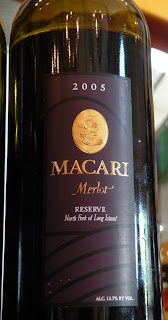 |
| 2005 Merlot Reserve |
Next was the 2007 Bergen Road, a “Macari favorite” and for good reason - this Meritage type wine (a sort of Bordeaux blend often done very nicely at several Long Island wineries) is complex and elegant. A deep ruby with a red-pink rim, the wine stains the glass with its intensity, and opens into aromas of seductive dark fruit and red fruit, smoke, deep spice, a bit of earth, chocolate, and wood, and lots of fruit and spice on the palate, with excellent structure and balance, a luscious texture, and a long finish. I would love to try this wine again in a few years and see how it has developed; this wine is stunning and very impressive.
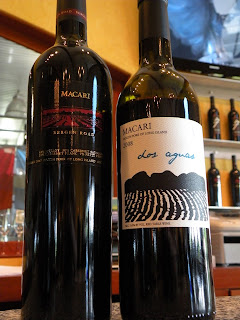 |
| 2007 Bergen Road and 2008 Dos Aguas |
The last red was the 2008 Dos Aguas, another Meritage, very dark with a color similar to Malbec, deep purple with a pinkish rim indicating its youthfulness. The aromas were of dark fruit, stewed berries, plum, and spice, and the flavors confirmed the aromas, with a bit more emphasis on the spice. Another nicely balanced wine with a long finish, this wine would pair nicely with meats.
Finally, it was time for the 2008 Block E, Macari’s lovely dessert wine of Viognier and Pinot Gris. The wine is a golden color, not overly viscous, with aromas of apricot, stone, honey, and a vegetal note, and flavors of apricot, peach, tropical fruit, and honey. The wine is soft and smooth, and remarkably light for a dessert wine, significantly lighter in density than a Sauternes, for example. I feel this dessert wine is food friendly in that it could also be paired with spicy cuisine, including Asian dishes, and not just dessert wine - or it could be paired with desserts, or enjoyed as a dessert on its own. I have always enjoyed Block E and the 2008 is as wonderful as I remembered previous vintages.
 |
| 2008 Block E |
I wrapped up my visit to Macari with a lovely conversation with Mr. Macari. I had a wonderful time at their tasting room and am looking forward to my next trip there, the wines are fantastic and Macari ranks among my favorite wineries on Long Island for their consistent good quality, beautiful vineyards and tasting room, and pleasant and knowledgeable staff. So the next time you’re visiting Long Island’s wineries, be sure to stop in at Macari’s tasting room.



